________________
PAINTINGS AND WOOD-CARVINGS
[PART VII The earlier manuscript of the undated Adi-puräna, too, had evoked certain parallels to the Caura-panicăsikā group. The cumulative evidence of these two manuscripts-the Adi-puräna and the Mahd-purdiņa of 1540-suggests that both of them are examples, amongst others also, of an emergent style which efloresces into the Caura-pañcasika style. They indicate, furthermore, ** that the origins of the Caura-pancasika style lie in the painting that was practised in northern India.
A survey of all these manuscripts executed in Delhi and the neighbouring regions gives us a fair idea of the style of painting as it developed in that region in the pre-Akbar period during the Lodi rule. It establishes, besides, that this style was related to and yet distinct from the style coeval in western India. For, when the style in northern India is compared to that of western India, the former reveals that it includes much greater number of illustrations in its texts--often to the extent of being needlessly repetitive. Again, in the organization of its textual and illustrated matter on a folio, the northern idiom is less inhibited and more inventive than the western idiom which has a very formal arrangement. The compositions are energetic and in costumes, architecture and furnishing the two idioms appear to portray local peculiarities.
As a style, the northern idiom presents a steady progression in its development by introducing new forms and experimenting with novel methods of composition. By contrast, the style in western India, though more sumptuous and elegant, tends to develop inwardly within its own framework and as a result becomes effete and static.
In 1556 Akbar ascended the throne of Delhi and the cultural ferment that characterized his reign seems to have had a very decided repercussion on the pictorial expression of the period. On the west-Indian style of painting, the effects can be observed in the treatment of human figures and their attire in many manuscripts amongst which can be counted the Sangrahani-sütra of 1583, executed in Matar' and a Yasodhara-carita of 1596 (col.-ill. 37). The same trend is also reflected in another Yasodhara-carita of 1590 executed in Amer, the capital of the Kacchwāhā Rājputs (plate 283B).
Though the Digambara manuscripts are outnumbered by the Svetămbara ones, there is no reason to believe that the Digambara community was copying the Svetăm bara for propaganda value. The real reason may well be that the Svetämbara Jainas were oriented towards this form of religious expression
* Khandalavala and Moti Chandra, op. cit., 1974. • Moti Chandra and Sbah, op. cit., 1968, pp. 367-68. * Khandalavala and Moti Chandra, op. cit., 1969, p. 69.
426




